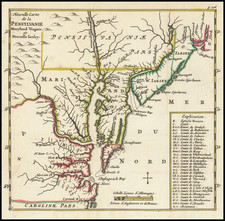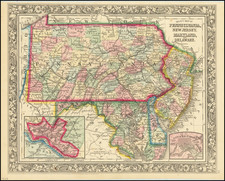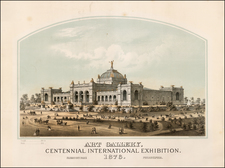Rare Colonial American View
Rare Robert Sayer / Scenographica America edition of Nicholas Garrison's view of the Moravian settlement at Bethlehem, Pennsylvania, one of the earliest large format views of an American Frontier settlement based upon the work of an American artist.
Nicholas Garrison's view of Bethlehem is one of the earliest obtainable images of the Moravian settlement at Bethlehem and one of the earliest known separately issued engraved images of an American frontier settlement. Garrison's view is based upon his 1754 ink and wash original in the collection of the Moravian Archives. While the view is known to print collectors from its later appearance under the imprint of Robert Sayer, who apparently acquired Isaiah Noual's original copper plate (which had almost certainly been privately printed for the Moravian Church), this original Garrison edition is of the utmost rarity.
Engraved shortly after the start of the French & Indian War, Garrison's view depicts a number of the earliest and most historically significant structures in Bethlehem, including the Crown Inn, shortly after Benjamin Franklin's brief residence at the Inn in 1755.
This first edition of Garrison's view is known in two examples, both in the Moravian Archives. Upon close examination, this first edition can be easily distinguished from Robert Sayer's later edition. The most noteworthy differences can be seen in the horse corral in the lower left. In Garrison's first edition, there is a horse lying on its back with legs in the air and a second horse below it at the fence posts, looking outward. In the later Sayer edition, the horse lying on its back has been removed from the image and the second horse is now shown inside of a newly engraved barn, added (rather awkwardly) in the middle of the horse corral.
Captain Nicholas Garrison Jr., a Moravian living in Bethlehem, was responsible for 4 notable early American views, including this view of Bethlehem, a view of the Philadelphia Alms House (1767) and views of Nazareth (1761) and Bethlehem (1784). Garrison was a prominent member of the Moravian Community, who came to Bethlehem with his father in 1740. Garrison accompanied Count Zinzendorf on excursions to Europe and captained at least one group of colonists from Europe to the settlement at the "Barony of Nazareth," the first short-lived Moravian settlement in Pennsylvania. In 1758, Garrison married Johanna Grace Parsons, daughter of William Parsons, the founder of the Moravian settlement at Easton and Junto compatriot of Benjamin Franklin.
Garrison and his wife moved to Philadelphia where he remained for nearly 20 years. Garrison and family fled Philadelphia during the British occupation of the City, returning to Bethelem, where he would later operate an express between Moravian settlements during the Revolution. According to Levering, Garrison was an accomplished draughtsman and sketcher, who drew views of a number of Moravian settlements, noting that 3 (Bethlehem 1757, Nazareth 1761 and Bethlehem (1784) were later engraved and printed (Levering, History of Bethlehem, Pennsylvania, 1741-1892, p 519, fn 14).
Among the more noteworthy landmarks in Garrison's view is the depiction of the as yet unnamed Tavern, which would become known as the Crown Inn (large dark structure in the foreground, between the horse corrals), one of the oldest structures in Bethlehem. Construction on the Inn began in December 1744. Upon its completion, it would become the first building erected in the Lehigh Valley as a public house of entertainment. Samuel Powell, an English Moravian, was the first proprietor. He also opened the first bookstore in the Lehigh Valley in the same location. The name, "Crown Inn", was first applied to the tavern in 1756, when a signboard emblazoned with the crown of George II was hung over the door.
During the French and Indian War, the Crown Inn would be the site of several important Indian Councils with the British Colonists and a haven for settlers from outlying parts of the Valley, who were fleeing the perceived Indian threats, following the Indian Massacre of Moravian Missionaries at Gnaddenhuetten (Weissport). It was this same massacre whch persuaded the Provincial authorities to commission Benjamin Franklin to take charge of the erection of a line of forts along the frontier. Franklin, with a guard of 150 men and a train of supply wagons, first arrived at the Crown Inn on December 18, 1755. On February 4, 1756, having completed Fort William Allen on the site of the present Weissport, he returned to the Crown Inn, before returning to Philadelphia.
Other important early places noted in the view include the Burying Gound (used from 1747 to 1763), the boys and girls reform school (1749-1753) and a number of the earliest merchant shops. While item u. in the key is listed as "Indian Houses," it is questionable as to whether these are the houses constructed by Teedyuscung, chief of the Delawares, who established a residence in town during the Indian Councils of 1757-1758, which was located east of the Crown Inn.
Rarity
The Sayer edition of the map is rare on the market. This is the second example we have offered for sale in the past 30 years.
Robert Sayer (ca. 1724-1794) was a prominent London map publisher. Robert’s father was a lawyer, but his older brother married Mary Overton, the widow of prominent mapmaker Philip Overton and the proprietor of his shop after his death. Mary continued the business for roughly a year after her marriage and then, in early 1748, it passed to Robert. Robert became a freeman of the Stationers’ Company later that year; his first advertisement as an independent publisher was released in December.
Sayer benefited from Overton’s considerable stock, which included the plates of John Senex. In the 1750s, Sayer specialized in design books and topographical prints, as well as comic mezzotints. In 1753, he, along with John Roque, published a new edition of Thomas Read’s Small British Atlas, the first of several county atlases that Sayer would publish.
Sayer’s business continued to grow. In 1760 he moved further down Fleet Street to larger premises at 53 Fleet Street. In 1766, he acquired Thomas Jefferys’ stock when the latter went bankrupt. In 1774, he entered into a partnership with John Bennett, his former apprentice. The pair specialized in American atlases, based on the work of Jefferys. They also began publishing navigational charts in the 1780s and quickly became the largest supplier of British charts in the trade.
Bennett’s mental health declined, and the partnership ended in 1784. As Sayer aged, he relied on his employees Robert Laurie and James Whittle, who eventually succeeded him. He spent more and more time at his house in Richmond. In 1794, he died in Bath.










![[ Virginia / Maryland / Chesapeake Region ] Pas Kaart van de Zee Kusten van Virginia Tusschen C. Henry ent Hooge Land van Renslaars Hoek. . .](https://storage.googleapis.com/raremaps/img/small/47255.jpg)


![1794 Land Survey Signed by Alexander McDowell D[eputy] S[urveyor]](https://storage.googleapis.com/raremaps/img/small/101014.jpg)
![[Jefferson's Notes on the State of Virginia] Observations sur la Virginie [with the map:] A Map of the country between Albemarle Sound, and Lake Erie, comprehending the whole of Virginia, Maryland, Delaware, and Pensylvania, with parts of several other of the United States of America. Engraved for the Notes on Virginia.](https://storage.googleapis.com/raremaps/img/small/51828.jpg)